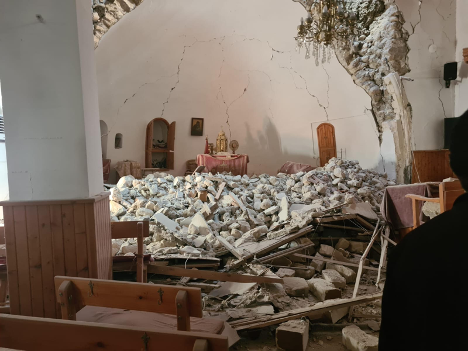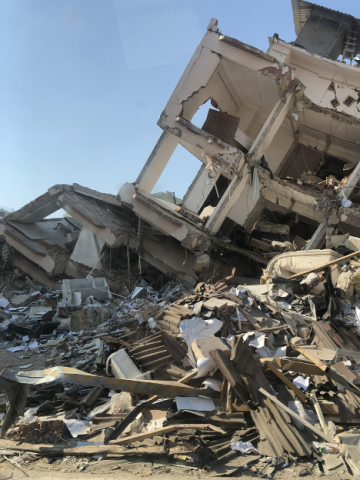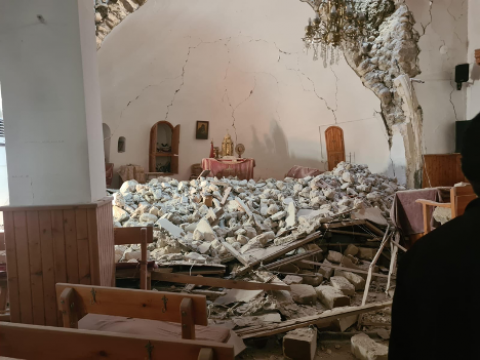Joel Christensen and Arie Amaya-Akkermans
March 15, 2023
Like many of us, I have been following the aftermath of the earthquakes in Turkey and Syria with dismay — there’s no real way to comprehend the scale of destruction and loss of life in the region. To make matters worse, reporting in US media has been limited, and the information coming out of the region has been limited by the obstacles of the chaos and the responses of the regional governments. We all know that the situation in the region is bad; what we understand less is that this is a generational devastation and the political structures are likely making it worse.
My friend and collaborator Arie Amaya-Akkermans has been on the ground in the region, writing essays for various media outlets, and helping where he can to assist people and bear witness to the destruction. We have been talking about ways to raise awareness about the extent of the earthquake’s impact and provide some ideas about what our professional society’s membership can do to help. The interview below has been lightly edited. A full transcript will be available on sententiaeantiquae.com.
Joel Christensen: What are the basic facts on the ground right now in Antioch after the earthquake?
Arie Amaya-Akkermans: On the 6th of February, in the very early hours of the morning, a massive earthquake rocked a large region of southern Turkey and northwestern Syria, causing unprecedented destruction to communities as distant as Diyarbakir and Antakya. In Turkey alone, 10 provinces were affected, a dozen cities have been destroyed, and the tally of dead is so large that it makes no sense to relay uncertain numbers, without counting the wounded here or the number of buildings that have collapsed or are no longer safe for habitation. During the first days, people were largely left to their fate, at least in Antioch, but through self-organization and the collective efforts of private individuals, donors, volunteers, and international organizations, relief aid began to be delivered. The government has, by now, joined these efforts.
But the seismic activity did not stop on the 6th with the 7.8- and 7.6-magnitude earthquakes. Tremors have been ongoing for weeks, and another earthquake, this time 6.4, with an epicenter near Samandağ, shook the earth on the 20th of February. At the time, I was in the region, and we were leaving the St. Ilyas Church, where volunteers had set up a soup kitchen for the displaced. Even though the relief efforts continue there, now the church has been destroyed, along with other churches in Antakya, Altınözü, Iskenderun, and Arsuz.
This ongoing situation also means that there’s no certain date in the horizon for the reconstruction of houses, even though many have been already slated for demolition. There’s no real clarity on what’s going to happen when. In the meantime, we’re talking about millions of displaced people, and specifically about Antioch: Antakya is a ghost city and it’s been largely emptied out; the city center is a ruin and the old city has been completely flattened, and with it, the synagogue, the Orthodox church, the Protestant church, and the mosque have vanished.
Other towns in the province that are known to classical archaeologists such as Arsuz, Samandağ, Defne or Iskenderun, have sustained extensive damage, and are certainly not suitable for habitation.
As far as I understand, the province of Hatay has received the most significant material damage, with over 25,000 apartments destroyed, although the news coverage was very poor in the first few days, until foreign journalists started making their way into Antakya and the surrounding region, including The Guardian, The Telegraph, and CBC. The true extent of the catastrophe is magnified by the personal stories told by survivors in the region about their search for missing relatives in the rubble, frequently without adequate tools, and often simply too late. Questions about decisions made by the authorities in the first days after the earthquake will define the Turkish political scene for years to come.

JC: What is the status of ancient heritage sites and museums in Antioch?
AAA: In the March issue of The Art Newspaper, I reported at length on the damage to archaeological sites and heritage buildings in the region, but basically, other than the churches described above, the panorama of archaeological heritage is as follows: Turkey’s most famous archaeological site, Gobekli Tepe, in the province of Șanliurfa, was within the affected area but remained unscathed. But the Gaziantep Castle, once a fortress of the Hittite empire built in the 2nd millennium BCE, but the core of which is the Roman-Byzantine construction between the 2nd and 5th century CE, has been almost completely leveled.
For Antioch, specifically, the Hatay Archaeological Museum, home to countless Roman mosaics, and the neighboring Museum Hotel — a controversial tourism project built above one of the largest mosaics ever found — survived almost unscathed. Damaged artifacts in the museum that fell to the floor are being restored, and according to pictures, additional measures have been taken to protect major pieces, such as the statue of Hittite king Suppiluliuma II and the Arsuz Steles, both containing rare inscriptions in Luwian. The Bronze Age excavation sites of Tell Tayinat — where Suppiluliuma was famously found a decade ago — and neighboring Tell Atchana, the source of many important cuneiform tablets and artifacts, have both sustained some damage, but they’ve been evacuated now with all the content of their storage.
A week after the earthquake, I visited the Hellenistic town of Seleucia Pieria, founded around 300 BCE, and the Vespasianus Titus Tunnel, from the 1st or 2nd century CE, in Çevlik, a suburb of Samandağ, and can attest to their survival then, but am unsure about what happened after the last earthquake on February 20. Other, more remote sites remain unaccounted for, such as the 6th-century-CE monastery of Saint Simon Stylites the Younger, perched at the summit of a distant hill, or the 10th-century-CE Monastery of Saint Barlaam, built on the ruins of an ancient temple over a hill that divides now between Turkey and Syria.
JC: What is the connection between the ancient past and the present in the region like?
AAA: The various pasts and presents of Antioch contain many different beginnings: Alalakh (Tell Atchana), the Middle Bronze Age city founded by the Amorites, and capital of the long-forgotten kingdom of Mukish, and the overlapping cities of Alalahu and Kinalua (Tell Tayinat) in the vicinity of Antioch, one mentioned in the archives of Ebla, and the other a Neo-Hittite Iron Age Kingdom. Both sites are located on the Amuq Valley, notable for a number of archaeological sites, situated at a crucial junction between Cilicia and the Mediterranean, bordering with Syria, the Anatolian plateau, and the Syro-Mesopotamian region, offering an unusual opportunity to understand a larger systemic context. Lake Amik was a large freshwater lake in the basin of the Orontes River that once surrounded these ancient settlements. Its waters have now disappeared, but not in antiquity — they were actually drained by the Turkish state after the 1940s, freeing land for cotton and repopulation, causing extensive environmental damage and the displacement or extinction of vast numbers of species. As you can see, the politics of the present are still affecting what remains of the ancient world and how.
This is the rich background of the prehistoric region of Antioch. By the time Antioch came into existence at the dawn of the classical world, the Amuq Valley had been settled since the Neolithic, and an ethnically diverse population was already speaking Greek. With the collapse of the Bronze Age, civilization didn’t just disappear in the northern Levant and the Syro-Anatolian states provided continuity into the Iron Age (James F. Osborne devoted an entire book to this). The port city of Al Mina, a trading port on the Mediterranean coast, is considered an early Greek trading colony, founded around 800 BCE, and substantial archaeological finds of pottery have been made there. Al Mina replaced Alalakh in importance at the dawn of the Iron Age. The bird sanctuary of Myleiha, near Al Mina, has now been affected by the earthquake, with rubble from the region being dumped there. Hellenistic Antioch would be founded by Seleucus I Nicator in 300 BCE (Seleucia Pieria as well), and the city served as capital to the Seleucid Empire, regional capital to the Roman and Byzantine Empires, capital of the Principality of Antioch. But after that period, it changed hands again several times, finally being annexed by Turkey after a contested referendum in 1939.
Although many of these events and states took place a long time ago, they still shape the cultural present. In a recent book-length portrait of the city, Andrea U. Di Giorgi and A. Asa Eser use extensive textual sources and archaeological data to highlight the disparity between the epigraphic/textual record and archaeological discoveries. This alerts us not only to crucial questions about gaps in knowledge, but also dispels the old-fashioned thesis that Antioch permanently collapsed after a series of earthquakes in the 6th century CE. The city’s identity is buried deep within its inhabitants, and the transformations of the city in between its different periods — classical, Roman-Byzantine, Christian, Islamic and beyond, all the way to the modern city now almost completely destroyed (and abandoned according to Wikipedia) — remain as fascinating as the geomorphological changes in the region, including a brand-new canyon created by the earthquakes in the district of Altınözü. The work of Helene Maloigne, some still unpublished, connects the European archives, the colonial expeditions of Leonard Woolley, and the cultural-political present of sites in the region. A lot remains to be studied from excavation archives.

JC: Modern Antioch is a place in Turkey where minorities were traditionally safe and thriving. How are these communities threatened by the earthquake and the aftermath?
AAA: It’s hard to describe how much these communities are threatened by the reality of the earthquake. The Jewish community has been lost for good after the destruction of the synagogue, the death of the leadership of the tiny community, recently in numbers as low as 15. The last Jew of Antakya, Ezra Cenidioḡlu, has now left the city. Jews have been present in the city since its Hellenistic foundation, and the city was also the main center of Hellenistic Judaism at the end of the Second Temple Period. It’s really unlikely that Jews will come back — unless it’s as a part of one of those heritage propaganda projects that the Turkish state has a fondness for, with buildings restored for communities that no longer exist, shuttered behind locks, and opened only once in a blue moon for a high-profile event or memorial. The commentary of local historian Emre Can Dağlioğlu, whom I interviewed about the future of regional heritage, goes to the heart of the matter: “A lot of people in Antakya have been displaced by the earthquake. We have to find a way to allow them to settle here again. These communities are irreplaceable.”
Churches of all denominations — Greek and Armenian Orthodox, Catholic, Assyrian, and Protestant — have been damaged or destroyed by the earthquake, and many fear that other heritage buildings will receive demolition orders, as did the St. Georgios Church in Altınözü, due to not being registered as a historical building. This order has been rescinded after public outrage. The reasons for this include the desire of communities to remain invisible as Orthodox, trying to avoid the association with Anatolia’s Greeks, another very complex matter in Turkey. Unless there is a serious drive from overseas to fund the restoration of churches, it will be very difficult for these communities to survive there, let alone to return to the region in sufficient numbers.
The situation with Alawites, the majority of the population around Samandağ, organized around far less centralized bodies, is even more complicated. While they lack the institutions to provide a cohesive program or unified front of reconstruction, this atomized structure might be to their advantage, as they do not necessarily rely on large institutional networks and have been constantly wary of state intervention anywhere. But in general, Alawites have felt the persecution of both the Ottoman rulers and the Turkish state, just like the Armenians that populated Samandağ before them, from the Massacre of Telal in 1517 to the intervention of the Turkish military in Iskenderun in 1938 that sought to expel all Arabs and Armenians.
The relation of all minorities to the modern state are always so fragile, in spite of appearances to the contrary and public relation ploys that aim to whitewash the hostility of the country towards its own minorities who are always trying to remain invisible, in order to remain out of trouble with a state highly zealous concerning its own historical fabrications. Many Alawites have remained around the location of their own houses, living in tents, fearful of permanent displacement.
JC: How could the academic community contribute to the recovery of Antioch?
AAA: First of all, the recovery of Antioch is likely the project of an entire generation, as is extensively documented in regard to state responses to earthquakes during the Roman and Byzantine era (archaeologist Jordan Pickett has written a detailed chapter for a forthcoming volume on Antioch). So far, the response of the current government has been shy, and a far cry from the massive infrastructure projects described by John Malalas’ Chronographia during the reigns of Caligula, Claudius or Trajan, comic as this might sound. At first sight, the natural outlet would be donations to approved charities, which in the case of Turkey, and specifically Antioch/Hatay, is a tricky matter. Corruption is endemic in large organizations, and new players such as Ahbap, founded by popular singer Haluk Levent in 2017, have been key in providing relief, but the current contributions have exceeded their logistical capacity. In order to support the continuous efforts of smaller organizations and individuals effectively, it is crucial to focus on targeted needs of the most vulnerable, and with guidance from those with the most intimate knowledge of everyday life in the region.
The online platform Nehna, founded over a year ago with a focus on the histories of minorities (particularly Orthodox Christians) from the Antioch region, turned into a social organization and activism front overnight in the aftermath of the earthquake, and has been connecting people with resources, established organizations, donors, media, and the Christian churches in the region. Nehna has made available online the banking details of different churches in need of financial resources to rebuild their communities and buildings. People who are interested in sponsoring specific targets or individual groups could contact them directly to discuss possibilities. In the month of May, I will be personally responsible for an online art auction, coordinated together with Lebanese auction house Artscoops, for which there will be an announcement soon. Other individual organizations abroad such as the Turkish Philanthropy Funds, AKUT, and UK-based Turkey Mozaik Funds, keep collecting funds to distribute to organizations in the field. More than anything, if you have colleagues and friends in Antioch, reach out to them and inquire for their welfare and offer any help you can.
Authors



